
Our Top 10 Spring Flowers and Plants
Our Top 10 Spring Flowers and Plants
Last time edited: 11-11-2024
Bring spring into your home and garden with our favorite spring flowers and plants! As the first rays of sunshine and spring blooms break through after a dreary winter, many feel the excitement of spring. We’ll show you various types of flowers that are characteristic of the season. From cut flowers to plants, both in the living room and in the garden. With our top 10 spring flowers and plants, you’re guaranteed a healthy dose of springtime joy!
- Tulip
- Narcissus
- Hyacinth
- Iris
- Peony (Paeonia)
- Muscari (Grape Hyacinth)
- Crocus
- Primula (Primrose)
- Star Hyacinth (Scilla)
- Helleborus
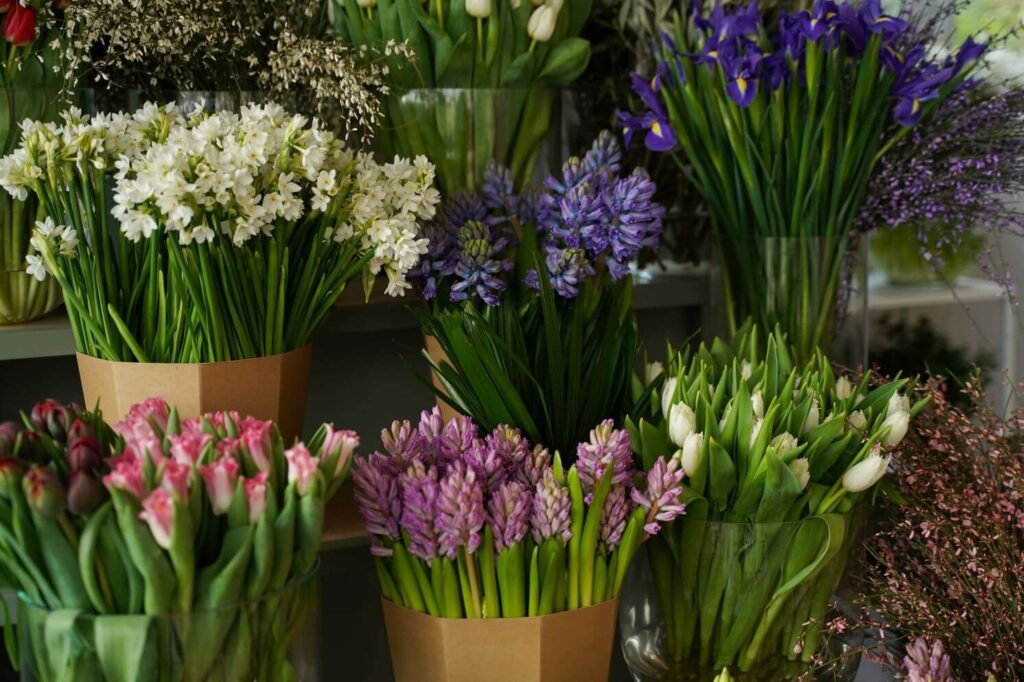
Did you know…
Decorum has various flower and plant concepts that add that little extra touch to a specific theme? These spring flowers and plants belong to the Yellow concept, which is perfect for Easter.
With Yellow, you celebrate new life full of growth and bloom, creating a truly vibrant spring celebration in your home! With these passionately cultivated flowers and plants of the highest quality, you bring lightness and freshness into your space and experience the ultimate feeling of spring. Plus, with our care tips, you can enjoy your spring flowers and plants even longer. We’re happy to tell you more about it.
Tulip
The tulip is recognized worldwide as a quintessential Dutch product and is a true spring flower. But did you know that the tulip bulb originally comes from Central Asia? The flowers made their way to Europe through the Ottoman Empire. Professor Carolus Clusius was instrumental in bringing these beautiful tulips to the Netherlands. Today, tulips are inextricably linked to Dutch culture and are available both as cut flowers and bulbs.
The tulip as cut flower
A bouquet of tulips brightens up any living room. Tulips are easy to combine with other flowers, such as gerberas or ranunculus. Buy the flowers while they are still in bud, so you can enjoy these spring beauties for longer. With the following care tips, you can keep this cheerful flower looking beautiful for as long as possible:
- Cut the stems straight. Tulips absorb a lot of water, causing them to grow rapidly. By cutting the stems straight, the cells in the stem remain small, allowing them to take up less water than stems that are cut at an angle.
- Remove excess leaves to ensure they don’t sit underwater.
- Place the tulips in a clean vase that is tall enough to accommodate tulips that will grow a few more centimeters. Fill the vase with water at room temperature (max. 5-10 cm) and add some flower food.
- Make sure the tulips are not in a draft, near heating, in direct sunlight, or near ripening fruit.
- Every few days, clean the vase and refresh the water.
The growers of this product are Van der Gulik & Borst Bloembollen. Both growers cultivate various types of tulips, but they also specialize in developing and growing new tulip varieties. A selection of these varieties is exclusively available under the Decorum Only label. Let your creativity flow with these special types and surprise yourself and those around you with a vibrant bouquet of tulips.
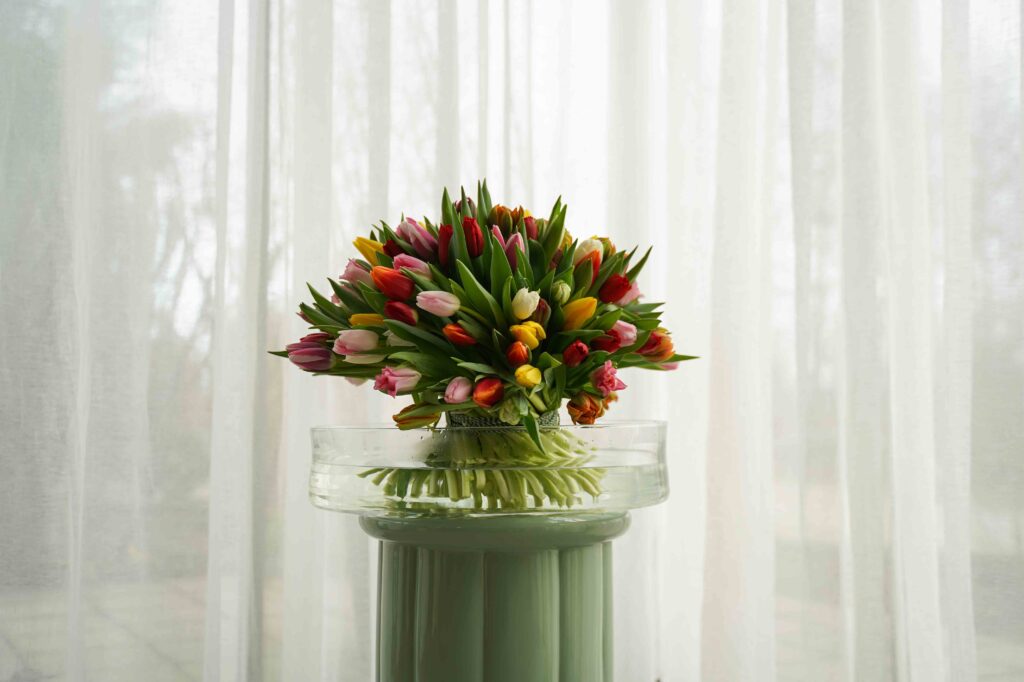
Tulip Bulbs
Potted tulips are available in many varieties. Do you prefer a type that stays short and compact, or would you rather go for a unique tulip variety, such as single or double-flowered? And what about the fringed tulip or the parrot tulip? There’s also a wide range of colors to choose from: white, red, yellow, pink, purple, orange, green, varied, or striped. With the following tips, you can enjoy the most beautiful tulips for as long as possible:
- Water the potted tulips once a week. If the soil feels lightly moist, the tulips have enough water. Be careful, as too much water can cause the bulb to rot.
- Place the pot of tulips in a bright, sunny spot, but not in direct, harsh sunlight.
- The tulips do not need extra feeding, as the bulbs contain enough nutrients to complete the blooming period.
- Once the tulip bulb has finished blooming, cutoff the stem. Clean the bulb, wrap it in newspaper, and store it in a dark, cool, and dry place. Replant the bulb in the ground between October and December, and enjoy a garden full of tulips the following year!
The grower of this product is HL Hogervorst. Gertjan and Sandra Hogervorst specialize in growing bulbs, which they use for forcing the bulbs in pots. Several years of work go into producing the potted tulips from HL Hogervorst before they leave the nursery.
Some products from this bulb nursery and forcing company are available under the Decorum Only label. These are products that are exclusively grown by this grower.
Narcissus
The narcissus, also known as the Easter flower, originates from South-Western Europe. Narcissus have been found in Northern Europe for a long time now. These spring flowers are named after Narcissus, a figure from Greek mythology. The mountain nymph Echo fell in love with the beautiful Narcissus, but he rejected her. As punishment, Apollo made Narcissus fall in love with his own reflection. Narcissus became so obsessed with his reflection in the water that he eventually drowned. Narcissus always seem to look a little downward, which is why these spring flowers are named after this ancient story. The Easter flowers are available in both bloom form and as potted narcissus.
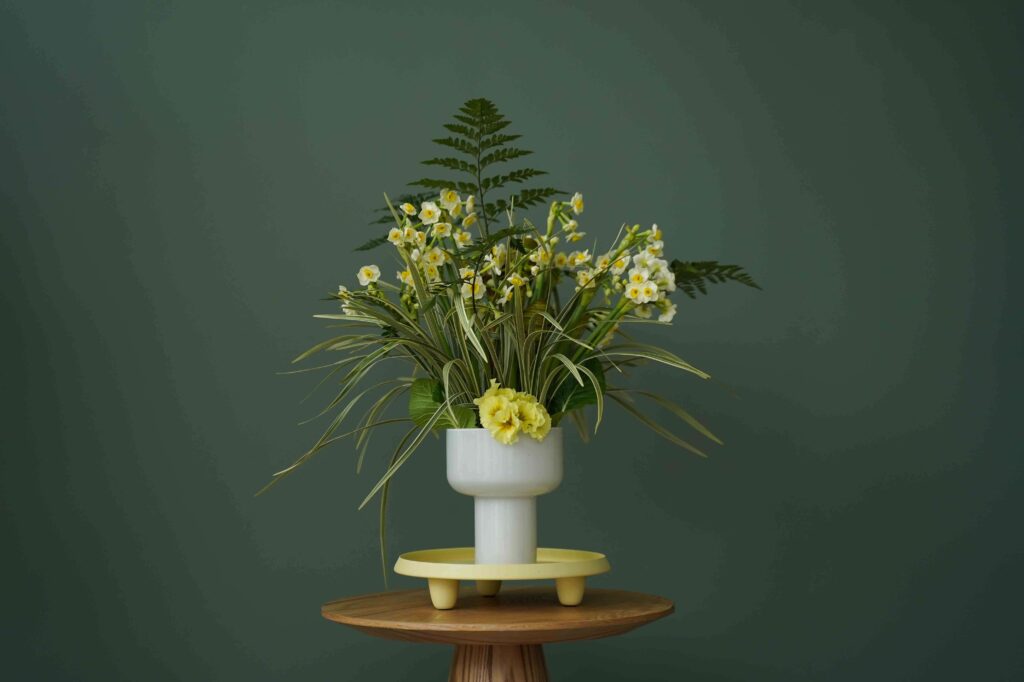
The Narcissus as a Cut Flower
These cheerful spring flowers are characterized by their trumpet-shaped blooms and smooth stems. Bright yellow is, of course, the most well-known color of the narcissus, but there are also beautiful combinations with white, salmon pink, or red. The flower features a trumpet surrounded by yellow or white petals that gently bend forward. In addition to the various color combinations, the narcissus comes in many forms: with leaves, without leaves, with large trumpets or smaller ones, fragrant or non-fragrant. With the following care tips, you can enjoy your narcissus in the vase for even longer:
- There may be some soil on the stems, so be sure to clean them well.
- Do not cut the bulb base off the stem to keep the narcissus sturdy in the vase.
- Choose a vase that is tall enough, clean it thoroughly, fill it with fresh water, and add some flower food.
- Place the narcissus in the water and keep the flowers out of direct sunlight, drafts, or near ripening fruit.
- Narcissus release a sap that many other flowers cannot tolerate, making them tricky to combine in a spring bouquet. However, the narcissus from Decorum has been specially treated, allowing them to be combined! This means you can still mix and match with other spring flowers in a beautiful arrangement.
The grower of this product is WF Leenen. Did you know that developing new varieties can take up to 30 years before they can be introduced? Grandpa Leenen has been working on developing new narcissus varieties since the start of this family business. Now, brothers Jaco and Dirk Leenen are reaping the benefits. Various narcissus varieties fall under the Decorum Only label, products exclusively grown by Decorum growers.
Narcissus Bulbs
From February onwards, narcissus can be found everywhere in nature. They symbolize a new beginning, as the narcissus heralds the arrival of a new season. These cheerful harbingers of spring can easily be brought into your home with potted narcissus. The buds are light brown and open quickly. If it’s very quiet in the house, you might even hear them rustling! Before you know it, you’ll have a pot full of beautiful blooming narcissus in your living room. With the following tips, your narcissus will receive the right care:
- Narcissus loves light but prefers not to be in direct sunlight.
- The flowers thrive best at a temperature of up to 20 degrees Celsius.
- Keep the potting soil moist; it should not dry out.
- Extra feeding is not necessary, as the bulbs contain everything the narcissus needs.
- A spent narcissus bulb can be saved by cutting off the stem, cleaning the bulb, wrapping it in newspaper, and storing it in a dark, cool, and dry place. Replant the bulb in the ground between September and November, and enjoy various types of narcissus in the spring.
- In winter, you can easily brighten your living room with a pot of narcissus, and they are also suitable for outdoors.
The grower of this product is HL Hogervorst. This nursery specializes in the cultivation and forcing of flower bulbs. HL Hogervorst produces various types of narcissus under the Decorum Only label, products that can only be found at Decorum.
Hyacinth
Around 1560, the hyacinth made its way to Europe from Turkey, Syria, and Lebanon. In the 17th and 18th centuries, the hyacinth was considered a luxury product so exclusive that only the wealthiest enthusiasts could enjoy this cheerful spring bloomer. The hyacinth is the flower of the sun god Apollo, symbolizing peace, devotion, beauty, power, and pride. Brighten up your home and garden with these colorful spring flowers in a bouquet or as potted plants!
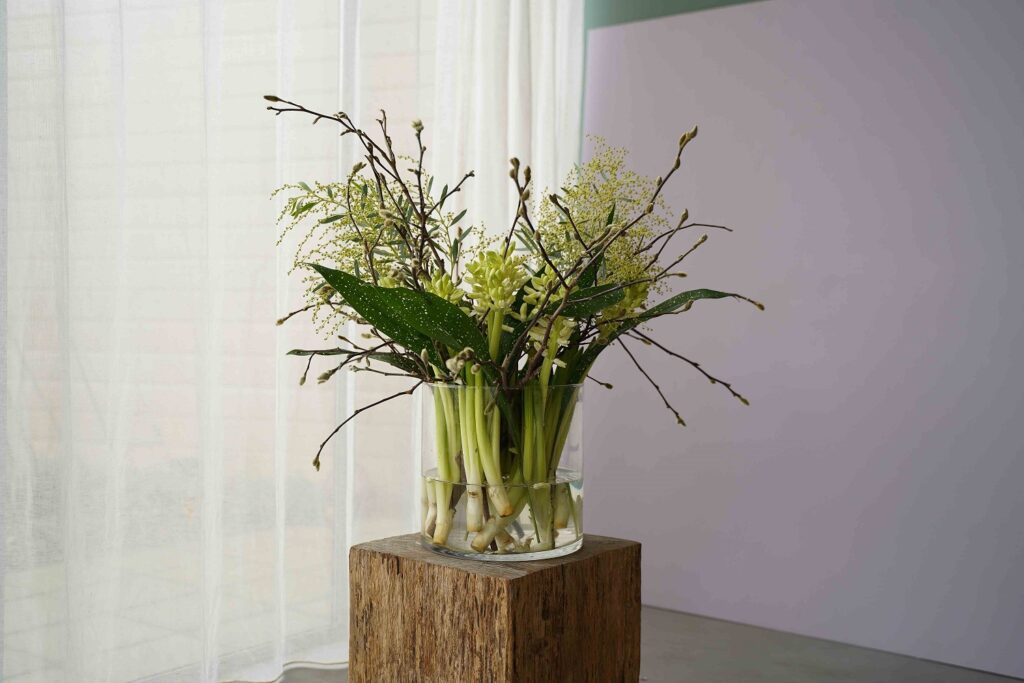
The Hyacinth as a Cut Flower
Hyacinths are available in many colors and are characterized by their fresh scent. The hyacinth is not sensitive to the sap of the narcissus, making them a delightful addition to a beautiful spring bouquet. Enjoy your bouquet of hyacinths for even longer with the following tips:
- Clean the stems. Do not cutoff the bulb base from the stem, as this keeps the hyacinth sturdy.
- Take a clean vase, fill it with tap water, and add some flower food.
- Keep your vase of hyacinths away from drafts, above the heating, or in direct sunlight.
The growers of this product are Straathof Flowers & Van Noort. Both growers specialize in cultivating these spring flowers. They produce high-quality hyacinths in a variety of colors, so there’s something for everyone.
Hyacinth Bulbs
Hyacinths also look stunning in pots. Thick leaves with a rounded tip grow from the bulb. During blooming, a stalk emerges from the center, filled with pink, purple, white, yellow, or redt flowers. These flower buds are called “nails.” One stalk can bear up to 50 nails. Hyacinth bulbs feel at home both indoors and outdoors. Here’s how to keep these cheerful spring flowers looking their best:
- Place the pot in plenty of light, but not in direct sunlight.
- The hyacinth thrives best at a temperature of up to 20 degrees Celsius.
- Keep the potting soil moist: it should not dry out.
- The bulb contains all the nutrients a hyacinth needs, so extra feeding is unnecessary.
- Once the hyacinth has finished blooming, cut off the stem, remove the bulb from the soil, and clean it. Wrap the bulb in newspaper and store it in a dark, cool, and dry place. Next year, you can reuse the bulb and enjoy beautiful hyacinths once again.
The grower of this product is HL Hogervorst. Gertjan and Sandra Hogervorst specialize in cultivating and forcing potted bulbs. Over three to four years, the bulb is propagated, treated for temperature, planted, covered with straw, sorted, fertilized, harvested, dried, and sorted again. Once the bulb is large enough, it is planted in a pot.
Iris
In Greek mythology, Iris is the goddess of the rainbow. The flower comes in various colors of the rainbow and is named after this mythological figure. The iris was first discovered in 1504 BC during the time of Pharaoh Thutmose, and it became a symbol of power. In Egypt, the flower represents victory. Over time, it has taken on additional meanings, such as prosperity, chivalry, and courage. Due to its rich history, these spring flowers can be found in many works of art, including Vincent van Gogh’s painting “Irises.”
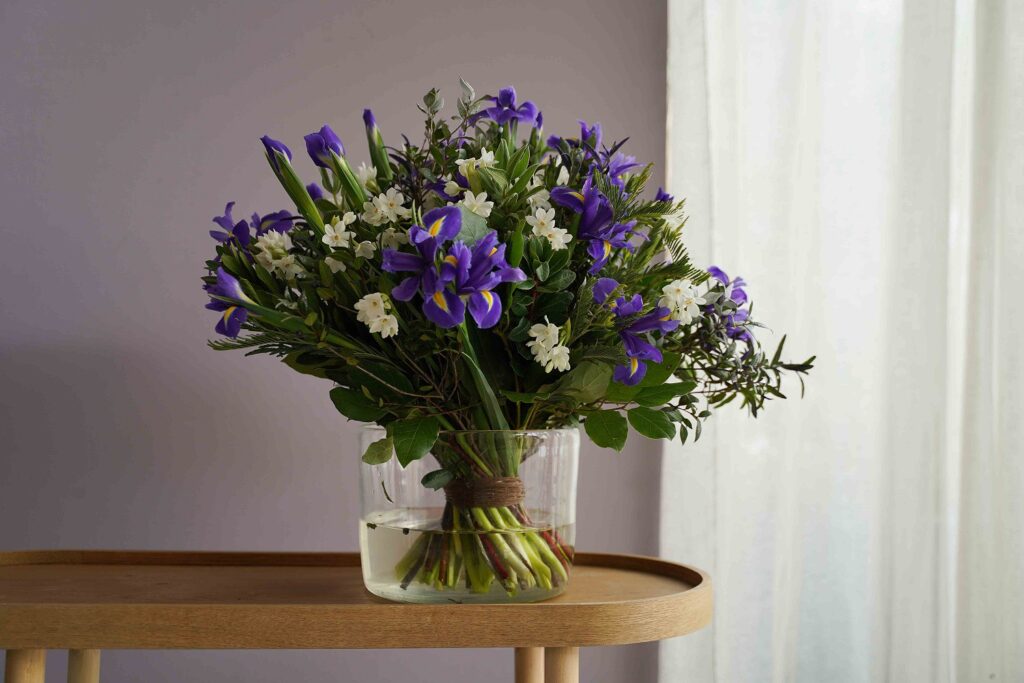
The Iris as a Flower
Create a work of art in your home by adding iris to your bouquet. With all its different colors, it is sure to be a standout and fits perfectly among other spring flowers. The iris is available year-round in blue and white, but during the non-winter months, you can also find it in many other colors. Here’s how to enjoy your iris for as long as possible:
- Ensure you have a clean vase, fill it with tap water, and add some flower food.
- Cut the stems at an angle and then place the flowers in the vase.
- Keep the vase away from drafts, above heating, in direct sunlight, or near ripening fruit.
The grower of this product is Middenweg Flowers. This grower can supply 23 varieties of iris year-round because they have split the growing season into two: an indoor and an outdoor season. From September to mid-June, they cultivate in Dutch greenhouses. When the summer months arrive in Spain, the irises are grown in outdoor fields. Middenweg Flowers offers various irises under the Decorum Only label, products exclusively grown by Decorum growers
The Iris as a Plant
In addition to the cut flower variety, the iris is also available as a plant. When the iris blooms, a stunning flower emerges, consisting of six petals—three upright and three hanging. The hanging petals are characterized by brightly colored spots and stripes, known as the honey mark. Insects see this as an attractive landing strip. Here’s how to care for your iris:
- The plant is suitable for both indoors and outdoors.
- Keep the potting soil moist; it should not dry out.
- The iris thrives at a temperature between 0 and 22 degrees Celsius.
- Place the iris in a bright and sunny spot.
- The iris is a perennial plant, so you can enjoy it for a long time! After flowering, cut away the old foliage so the bulb can prepare for a new growth and blooming cycle.
The grower of this product is HL Hogervorst. This grower specializes in cultivating and forcing bulbs. Throughout the growing process, great attention is paid to people and the environment. Crop protection agents, fertilizers, water usage, energy, and waste are all recorded and minimized where necessary.
Peony (Paeonia)
The peony (Paeonia) originally comes from China and, despite what the name suggests, is not related to the rose. The peony was cultivated for its roots, which were believed to have blood-stopping and fever-reducing properties. The meaning of a peony is love & romance and happiness & prosperity. From 1800 onwards, the peony made its way to Europe and America. These spring flowers were extensively hybridized from the late 19th century, allowing you to enjoy many varieties of peonies in a wide range of shapes and colors. The peony is also recognized for its wonderfully sweet fragrance. Here’s how to keep a bouquet of peonies looking beautiful in the vase:
- Make sure to use a clean vase, fill it with tap water, and add some flower food.
- Cut the stems of the flowers at an angle and remove any excess leaves so nothing hangs in the water.
- Place the vase in a reasonably cool spot, away from drafts and ripening fruit.
The grower of this product is Borst Bloembollen. Besides their tulips, Borst Bloembollen also grows several varieties of peonies. This gives them a long flowering assortment. Borst pays close attention to the maturity of the flowers. For example, they are cut at the right time and the maturity must be the same for each batch.
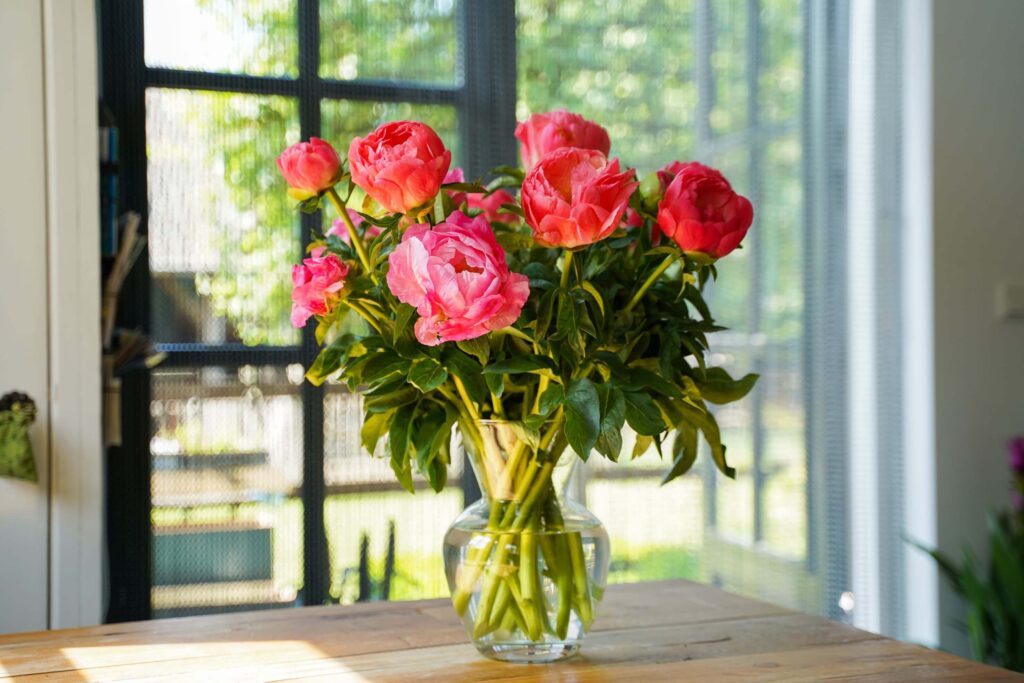
Muscari (Grape Hyacinths)
As nature is still in its winter slumber, the muscari bravely emerges as one of the first species to bring some color into the world. Due to its cluster of blue flowers, this spring plant is commonly known as grape hyacinths. The smaller stem is also characteristic of this charming flower. Originating from regions around the Mediterranean, it is a distant relative of the hyacinth. With the following tips, you can enjoy your muscari for as long as possible:
- Grape hyacinths prefer to be in full sun to partial shade.
- The cooler they are, the longer they bloom.
- The plant does not require extra nutrients, as these are already present in the bulbs. They thrive best in sandy soil.
- The muscari grows to a height of 10 to 25 cm. For the best effect, plant a few together, either in a pot or in the ground.
The grower of this product is HL Hogervorst. Did you know that this nursery grows its own bulbs for forcing? This way, they know exactly what quality they have on hand and provide a 100% bloom guarantee! The muscari mix from HL Hogervorst is available under the Decorum Only label.
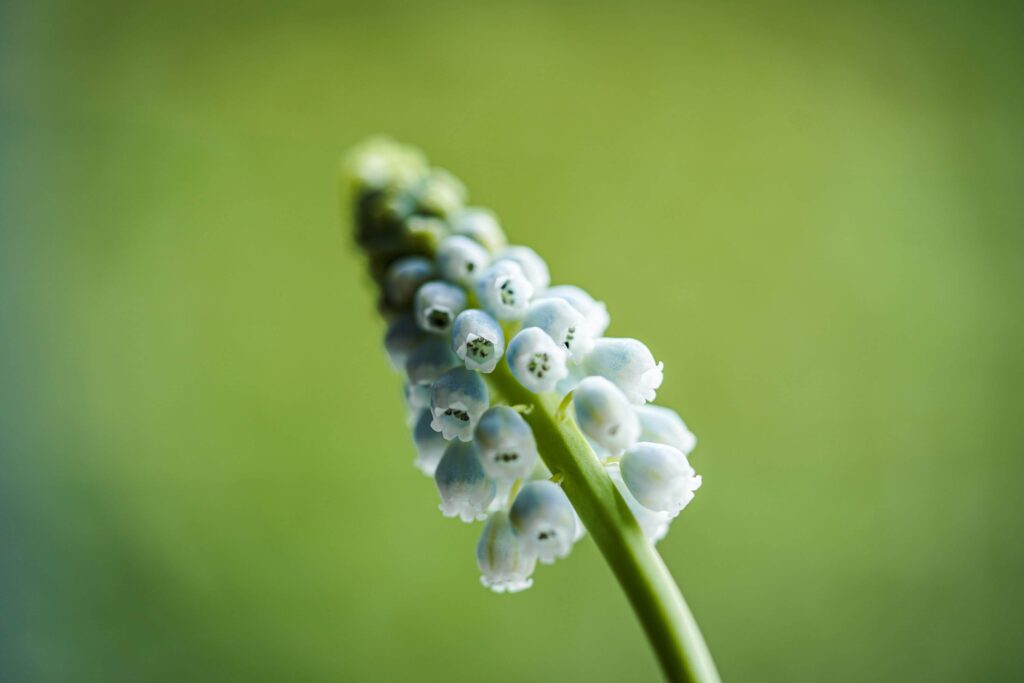
Crocuses
Just like muscari, crocus bulbs emerge early from the ground to brighten up nature. This plant, with its iris-like flower, is often found in colors such as white, yellow, and purple. Crocuses originate from the mountains around the Mediterranean. In the wild, they thrive on rocky slopes, meadows, forest edges, and scrubland, but they also do well in the backyard! With the following tips, you can enjoy these spring flowers for even longer:
- Crocuses thrive in full sun or light shade.
- Crocuses do not need extra nutrition because all the nutrition they need is in the bulbs.
- Crocuses match well with other spring-flowering bulbs and can easily be planted in layers.
- The crocus blooms for several years. If the bulbs stop blooming after a few years, you can dig them up and spread them over wider ground.
The grower of this product is HL Hogervorst. Before a bulb product leaves the nursery, several years of work have already gone into it. HL Hogervorst has a wealth of knowledge about this process and has been applying it for over five decades.
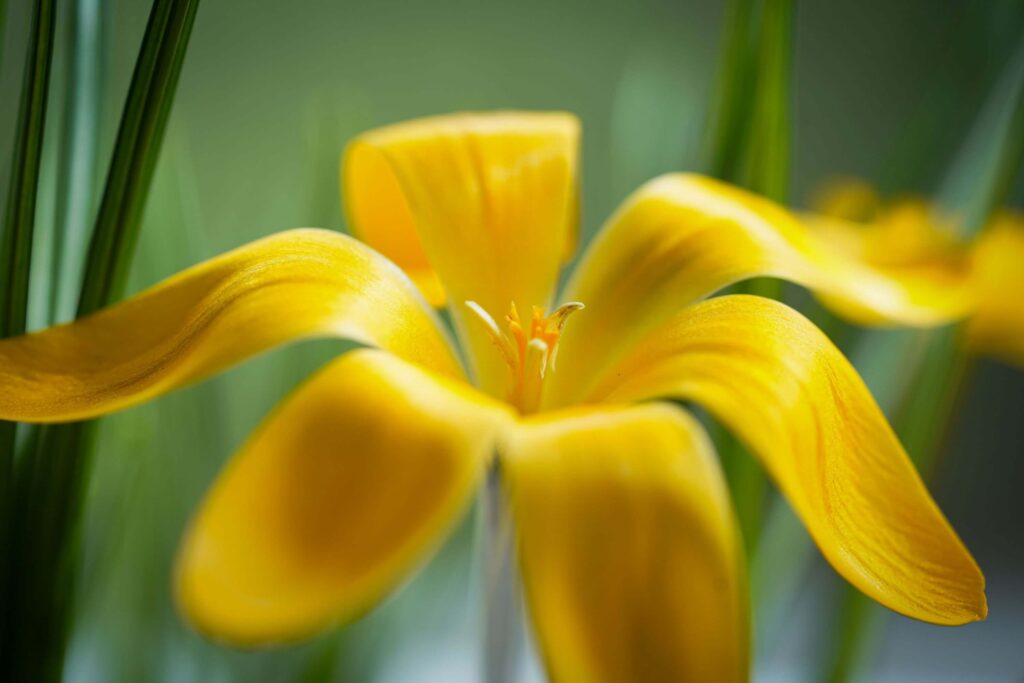
Primula (Primrose)
The primula, also called primrose, is common in the mountains of the northern hemisphere. It is a typical spring bloomer that adds color to both homes and gardens. The colors of primroses vary depending on how they are pollinated in nature. For example, primroses in low-lying areas tend to be yellow because they are pollinated by bees. In higher elevations, primroses are pollinated by butterflies, resulting in white, pink, blue or violet flowers. Isn’t that extraordinary?
Decorum’s primula grower is Ammerlaan-Sosef. From early December through April, this grower delivers the Touch Me primula. With its cheerful blooms, you can welcome spring into your home early. It is one of the few plants that blooms so early. Ammerlaan-Sosef’s primroses are available in many colors and sizes and have a flowering guarantee of at least 30 days. Here’s how to care for your primula indoors:
- The plant prefers not to be in a draft or in bright sunlight.
- You must keep the potting soil moist. It should not dry out.
- Fertilizing is not necessary. The primula has everything you need to get through the flowering period.
Primulas are suitable for indoors, but there are also varieties that love to brighten up the garden. If you want to place a primula in the garden, it’s best to avoid spots with direct sunlight or drafts. Keep the potting soil moist. During the blooming period, you can give this plant some fertilizer. Primulas that are suitable for outdoor use are hardy and will bloom again in the spring.
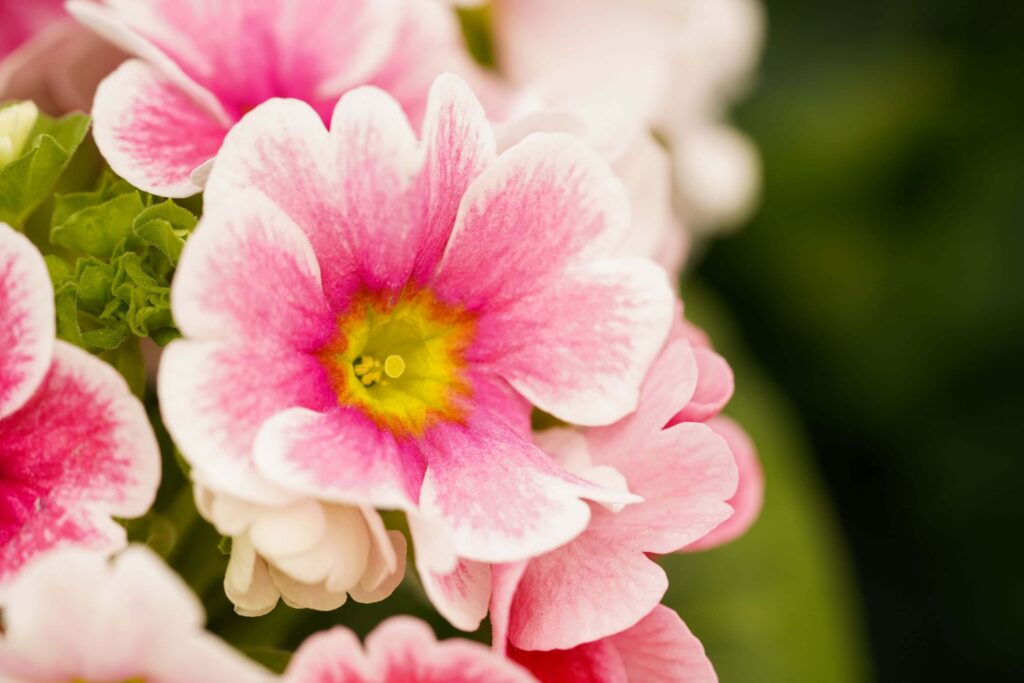
Star Hyacinth (Scilla)
The star hyacinth, also known as Scilla, is found in southern Europe and North Africa. The scilla is a bulbous plant characterized by multiple stems adorned with six-petaled flowers. They come in a variety of colors, including blue, white and soft pink.
With these care tips for your star hyacinth, you will not only brighten up your garden, but also enjoy the colorful flowers longer:
- Keep the soil moist; it should not dry out. be careful because too wet soil can cause Scilla bulbs to rot.
- Star hyacinths like a bright, sunny spot.
- Scillas do not like to be exposed to frost. If necessary, cover them with a layer of leaves.
- The Scilla has all the nutrients it needs stored in the bulb, so additional feeding is not necessary.
- Remove the Scilla bulbs from the ground when the flowers have bloomed, clean them, wrap them in newspaper and store them in a dark, dry and cool place. From September to December, you can plant the bulbs back in the ground to enjoy the beautiful blue and white Scillas again in spring.
The grower of this product is Vreugdenhil Bulbs & Plants. This grower specializes in growing bulbous and tuberous plants. Vreugdenhil is strong in customization. With different themes, added value and varying order volumes, the grower is always ready to serve its customers.
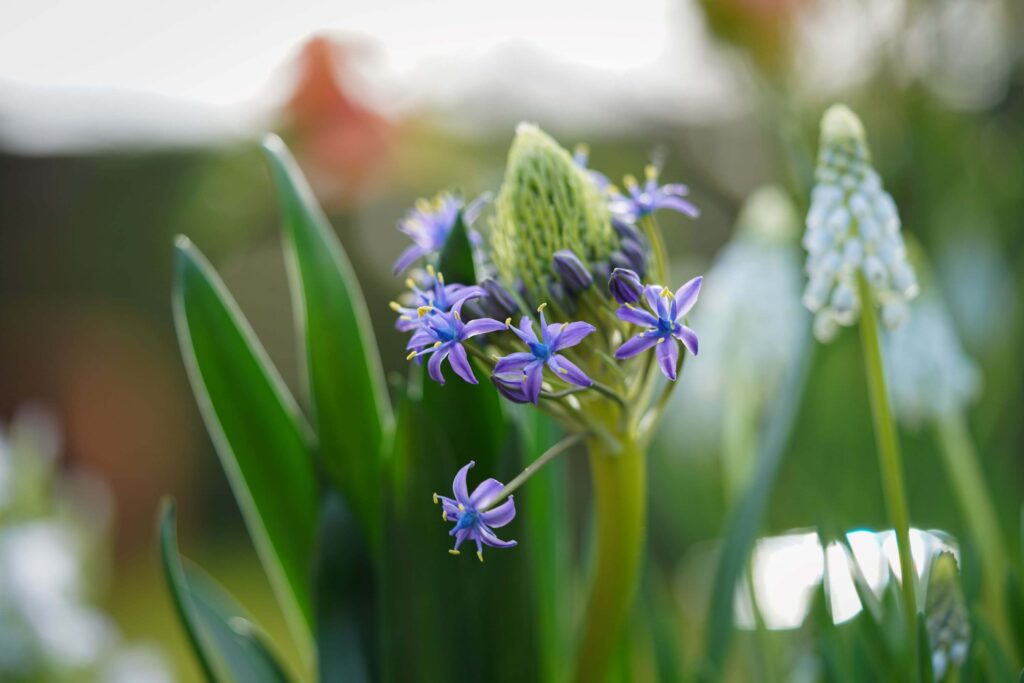
Helleborus
Helleborus is also called Christmas rose because this plant produces beautiful flowers in the heart of winter. Since it also blooms in early spring, it can be categorized as a spring bloomer. The flowering period of hellebores is from January to April. Christmas roses are native to the eastern Alps, Apennines and Carpathians. They are available in different colors, such as white, pink or purple. The following tips will help you enjoy your hellebores for as long as possible:
- The location of the Christmas rose is best in partial shade. Avoid direct sunlight.
- Remove dead leaves regularly and prune the hellebores after flowering.
- In winter, fertilize the plant once a month.
- In winter, Hellebores can dry out quickly due to cold winds. Pay close attention to the weather forecast and water before it freezes. Watering on frozen soil is pointless. That freezes and damages the plant.
The growers of the helleborus are Freek van der Velden and Van den Berg De Lier. Both growers pay close attention to the quality of their products and closely monitor the growth process. They are forward-thinking in sustainability and eagerly embrace new challenges and innovations. Only the finest Christmas roses are supplied to Decorum by these growers.
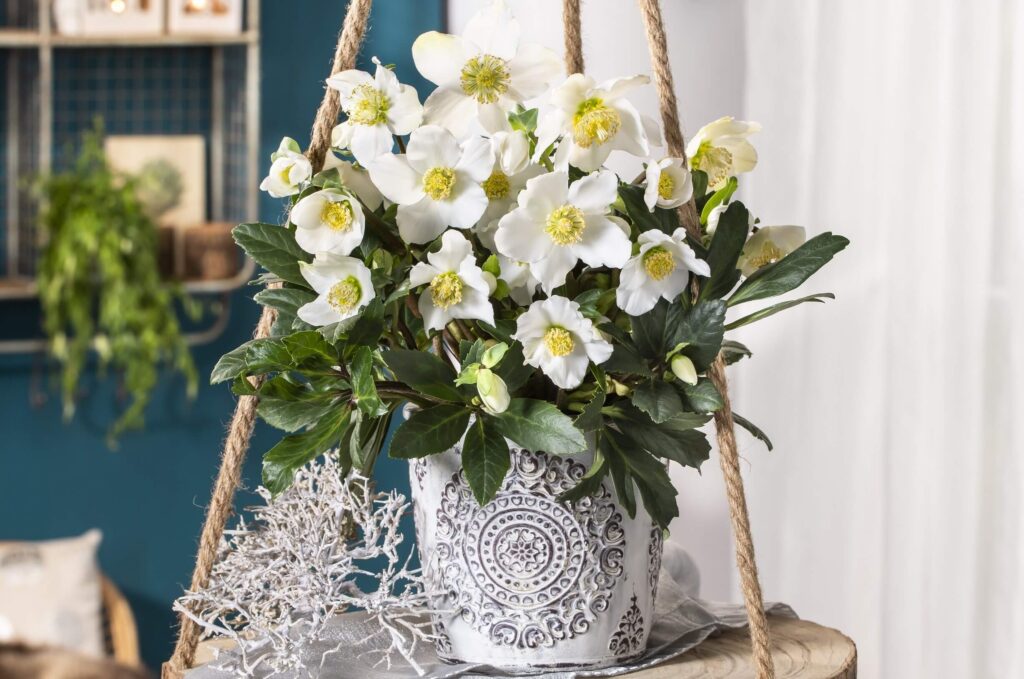
Are you a fan of potted bulbs?
Totally a fan of potted bulbs? At Decorum, we have many more tips and tricks to get the most out of your spring flowers and bulb plants. Prefer cut flowers and beautiful spring bouquets? We have tips for that too, so you can enjoy your bouquet longer.
Enjoy the first rays of sunshine and all the scents and colors of spring with our top 10 spring flowers and plants!

